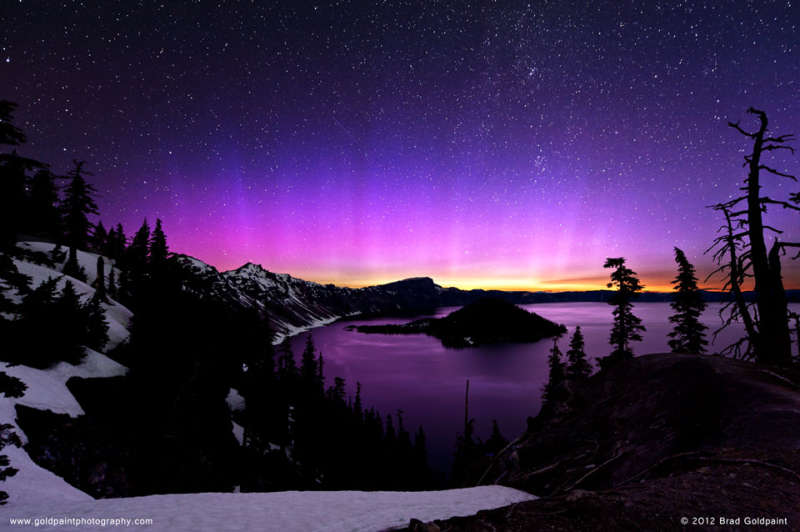
|
Credit & Copyright: Brad Goldpaint
(Goldpaint Photography)
Explanation:
Why is this aurora strikingly pink?
When photographing picturesque
Crater Lake in
Oregon,
USA last month, the background sky lit up with
auroras
of unusual colors.
Although much is known about the
physical mechanisms
that create auroras, accurately predicting the occurrence and colors of auroras remains
a topic of investigation.
Typically, it is known, the lowest
auroras appear green.
These
occur at about 100 kilometers high and involve atmospheric
oxygen atoms excited by
fast moving plasma from
space.
The next highest auroras -- at about 200 kilometers up --
appear red, and are also emitted by resettling atmospheric
oxygen.
Some of the highest auroras visible -- as high as 500 kilometers up --
appear blue, and are
caused by sunlight-scattering nitrogen ions.
When looking from the ground
through different layers of distant auroras,
their colors can combine to produce unique and spectacular hues,
in this case rare pink hues seen above.
As Solar Maximum nears over the next two years,
particle explosions
from the Sun are sure to continue and likely to create even more
memorable nighttime displays.
Students: Browse a free
online astronomy course.
|
January February March April May June July August September October November December |
| |||||||||||||||||||||||||||||||||||||||||||||||||||||||
NASA Web Site Statements, Warnings, and Disclaimers
NASA Official: Jay Norris. Specific rights apply.
A service of: LHEA at NASA / GSFC
& Michigan Tech. U.
Based on Astronomy Picture
Of the Day
Publications with keywords: aurora - Sun
Publications with words: aurora - Sun
See also:
- APOD: 2025 December 7 Á The Sun and Its Missing Colors
- APOD: 2025 May 21 Á International Space Station Crosses the Sun
- APOD: 2025 March 16 Á Venus and the Triply Ultraviolet Sun
- APOD: 2025 January 7 Á A New Years Aurora and SAR Arc
- APOD: 2024 December 8 Á Aurora around Saturns North Pole
- APOD: 2024 October 16 Á Colorful Aurora over New Zealand
- APOD: 2024 October 13 Á Aurora Timelapse Over Italian Alps
